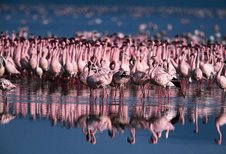Uganda is a well-watered country with nearly, one-fifth of the total area, or 44,000 square kilometers, is open water or swampland. Four of East Africa's Great Lakes--Lake Victoria, Lake Kyoga, Lake Albert, and Lake Edward--lie within Uganda or on its borders. Lake Victoria dominates the southeastern corner of the nation, with almost one-half of its 10,200-square-kilometer area lying inside Ugandan territory. It is the second largest inland freshwater lake in the world (after Lake Superior), and it feeds the upper waters of the Nile River, which is referred to in this region as the Victoria Nile.
Spectacular waterfalls occur at Murchison (Kabalega) Falls on the Victoria Nile River just east of Lake Albert. At the narrowest point on the falls, the waters of the Nile pass through an opening barely seven meters wide. One of the tributaries of the Albert Nile, the Zoka River, drains the northwestern corner of Uganda, a region still popularly known as the West Nile.
Taking a look at the great lakes in Uganda we find Lake Albert. Also known as Albert Nyanza and formerly Lake Mobutu Sese Seko, it is one of
the African Great Lakes. It is Africa's seventh largest lake, and ranks as the
world's twenty-seventh largest lake by volume.
Located in
the center of the continent, on the border between Uganda and the Democratic
Republic of the Congo – formerly Zaire, Lake Albert is the northern most of the
chain of lakes in the Great Rift Valley; it is about 160 km (100 mi)
long and 30 km (19 mi) wide, with a maximum depth of 51 m
(168 ft), and a surface elevation of 619 m (2,030 ft) above sea
level.
At the
southern end of the lake, where the Semliki comes in, there are swamps. Farther
south emerge the mighty Ruwenzori Range, while a range of hills called the Blue
Mountains soar over the northwestern shore. The few settlements along the shore
include Butiaba and Pakwach.
Recently, Heritage Oil and Tullow Oil companies have announced major oil finds in the Lake Albert basin, with estimates that the multi-billion barrel field will prove to be the largest onshore field found in sub-saharan Africa for over twenty years.
Lake George or Lake Dweru is part of Africa’s great
lakes system though it is not considered one of the great lakes. It covers a
total surface area of 250 km². Like the other lakes in the region it was
named after a member of the British royal family, in this case Prince George.
It drains to the southwest into Lake Edward through the Kazinga Channel.
Lake Edward or Edward Nyanza is the smallest of the
African Great Lakes. It is located in the western Great Rift Valley, on the
border between the Democratic Republic of the Congo and Uganda, with its
northern shore a few kilometers south of the Equator. The lake was named by the
explorer Henry Morton Stanley in honour of Prince Albert Edward, The Prince of
Wales.
Stanley
first saw the lake in 1875, and thinking it was part of Lake Albert, named it Beatrice
Gulf. On his second visit in 1888 through 1889, he realized that there were
two independent lakes, and gave it its current name. In the 1970s and 1980s,
Uganda and Zaire (Democratic Republic of the Congo) renamed it Lake Idi Amin or Lake Idi Amin Dada after Ugandan
dictator Idi Amin. After his overthrow in 1979, the name was changed back to Lake
Edward.
At a glance, Uganda boasts one of the greatest African lakes. From
north-most Lake Albert to the shores of Lake Victoria, Uganda has greatest
diversity of lake vacations in the regions all of which can be explored in
African safaris.









No comments:
Post a Comment